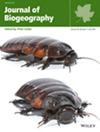Ophiuroidea Gray, 1840 potential species richness across the eastern Pacific: An approach using species distribution modelling
Abstract
Aim
To estimate patterns of potential species richness (PSR) and identify shallow-water Ophiuroidea hotspots based on their modelled distribution throughout the eastern Pacific Ocean (EP).
Location
Eastern Pacific Ocean.
Taxon
Echinodermata: Ophiuroidea.
Methods
We compiled and analysed the occurrence of 137 shallow-water (≤200 m) species of Ophiuroidea from the EP using Species Distribution Models (SDM; use of Maxent) and buffering for rare species to create the first maps of PSR of the class in the EP to gain insight into their patterns.
Results
The highest PSR was found in mid-latitudes, decreasing towards high latitudes, denoting a robust latitudinal pattern. All PSR hotspots were found in mid-latitudes and correspond to northern Mexico, the area between Corinto (Nicaragua) and the Gulf of Panama, and the Galapagos Islands. The pattern is mainly linked to topographic configuration, although the models also suggest temperature and other environmental factors as important. Additionally, the pattern correlates (R = 98) with the pattern of the family Amphiuridae, suggesting that its richness can be used as a proxy for exploring Ophiuroidea richness patterns elsewhere.
Main Conclusions
The richness of Ophiuroidea from the EP follows a latitudinal pattern as do other invertebrate groups. The Gulf of California, Central America, and Galapagos Islands are confirmed as hotspots of Ophiuroidea richness. However, other significant areas include the west coast of southern Baja California, Chiapas, Guatemala, and Nicaragua. PSR patterns are influenced by diverse environmental variables and the distribution patterns of the most conspicuous families. SDMs are useful for understanding large-scale distribution patterns. This work is the first PSR assessment of marine invertebrates from the EP.

 求助内容:
求助内容: 应助结果提醒方式:
应助结果提醒方式:


